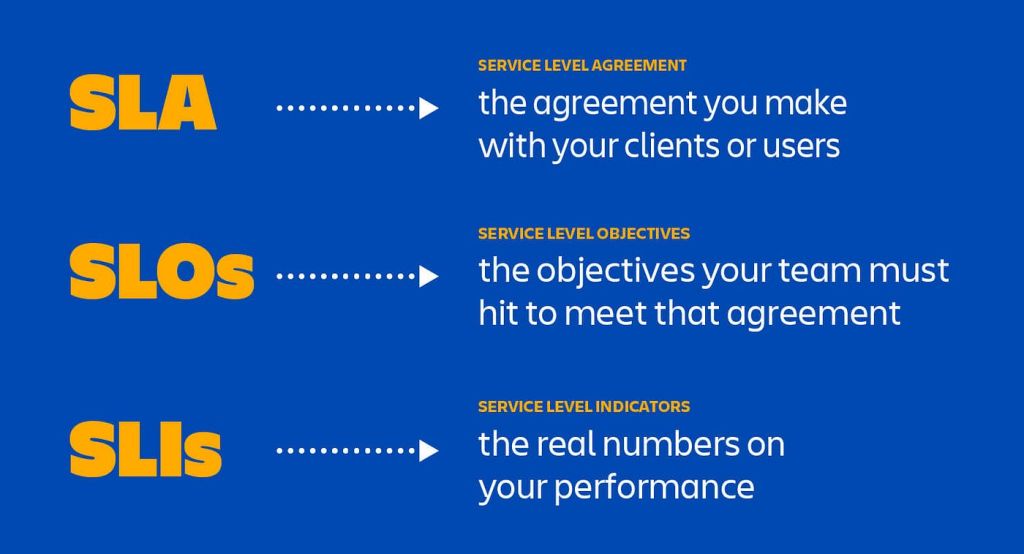
The landscape of SLO and SLA tools in 2024 is rich and diverse, offering options for a range of needs and budgets. Here’s a breakdown of some of the key players:
Dedicated SLO/SLA Monitoring Tools:
- Prometheus with Grafana: Open-source powerhouses, Prometheus collects metrics while Grafana displays them in insightful dashboards for SLO visualization and alerting.
- Site24x7: Cloud-based platform offering comprehensive SLO/SLA monitoring across infrastructure, applications, and APIs. Supports multiple vendors and cloud providers.
- VictorOps: Focuses on alerting and escalation for SLO breaches, notifying the right people quickly and efficiently through various channels.
APM and Infrastructure Monitoring Tools:
- Datadog: Provides comprehensive application performance monitoring (APM) and infrastructure monitoring, including SLO/SLA tracking and alerting.
- New Relic: Offers robust APM capabilities and real-time SLO/SLA dashboards with insights into key service-level metrics.
- Dynatrace: AI-powered monitoring platform enabling advanced SLO/SLA management with anomaly detection and automatic problem resolution.
Cloud-Native Monitoring Solutions:
- Amazon CloudWatch: Built-in monitoring service for AWS, offering cost-effective SLO/SLA tracking for smaller cloud deployments.
- Azure Monitor: Comprehensive solution for Azure environment monitoring, including infrastructure, containers, and applications, with SLO/SLA capabilities.
- Google Cloud Monitoring: Integrated solution for GCP monitoring, with strong emphasis on scalability and data analysis for SLO/SLA management.
Other Notable Tools:
- Prometheus Operator: Kubernetes-native solution for managing and deploying Prometheus for SLO/SLA monitoring in containerized environments.
- Prometheus Alertmanager: Robust alerting engine for Prometheus, notifying stakeholders effectively for SLO breaches.
- Sentry: Error monitoring and bug tracking platform that offers insights into service health and potential SLO/SLA violations.
Choosing the Right Tool:
Selecting the best SLO/SLA tool depends on various factors, including:
- Infrastructure footprint: On-premises, cloud, or hybrid environment?
- Monitoring needs: Application performance, infrastructure health, or specific service metrics?
- Budget: Open-source, freemium, or paid subscription?
- Technical expertise: Ease of use and administration requirements.
- Integration needs: Compatibility with existing tools and workflows.
Best Practices for Effective SLO/SLA Management:
- Set clear and measurable SLOs: Align SLOs with your business objectives and define them using relevant metrics and timeframes.
- Monitor and track SLOs consistently: Choose tools that provide robust monitoring and alerting for SLO breaches.
- Communicate SLOs and SLAs effectively: Share SLOs and SLAs with stakeholders to ensure alignment and accountability.
- Analyze SLO data regularly: Identify trends and patterns in SLO data to improve service levels and prevent future breaches.
- Continuously review and update SLOs: Adapt SLOs to changing business needs and infrastructure updates.
Remember, SLOs and SLAs are only valuable tools when actively managed and leveraged for continuous improvement. By choosing the right tools and following best practices, you can ensure your services meet performance expectations and deliver a reliable experience for your users.
Latest posts by Rahul Singh (see all)
- Mutual of Omaha: Selection and Interview process, Questions/Answers - April 15, 2024
- AES: Selection and Interview process, Questions/Answers - April 15, 2024
- Amphenol: Selection and Interview process, Questions/Answers - April 15, 2024

